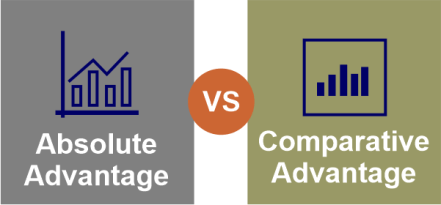Absolute vs. Comparative Advantage: What's the Difference?Two key ideas in economics and global commerce are absolute advantage and comparative advantage. They both have a huge impact on how and why countries and companies allocate resources to the creation of specific commodities and services. When one party can create an item more swiftly and profitably than another country or competing corporation, this is referred to as having an absolute advantage. On the other hand, comparative advantage considers the opportunity costs of selecting to produce a variety of commodities with restricted or limited resources. 
What is Absolute Advantage?The contrast between the differing capacity of companies and countries to produce goods successfully forms the foundation of the concept of absolute advantage. In addition, it looks at ways to produce goods and services for less money than rivals by using fewer inputs during production. This study aids nations in avoiding the production of goods and services that would be in little to no demand and result in losses. The kind of commodities a nation chooses to manufacture can be significantly influenced by its absolute advantage (or disadvantage) in a certain industry. Several factors that might give a company an unassailable edge include:
ExampleItaly is stated to have an absolute edge in the automobile industry. For instance, if Japan and Italy both have the ability to build automobiles, Italy will be able to construct sports cars quicker, at a higher quality, and for a greater profit. However, Japan could be better off focusing its limited human resources and resources on other industries or different types of vehicles, including electric automobiles. By doing this, the nation may enjoy an unbeatable edge rather than attempting to match Italy's effectiveness. In this way, both economies benefit from their absolute advantages. What is Comparative Advantage?Comparative advantage looks at the output as a whole. This viewpoint is supported by the idea that a nation or company may provide a range of goods and services rather than concentrating on just one. Analysts often evaluate the opportunity cost of selecting one option over another when the profit from two items is realized. In simple terms, one will usually choose any low-cost product if another similar product with a higher price is available. This is what we refer to as an opportunity cost. ExampleFor illustration, suppose China has the resources to manufacture ten computers or ten cell phones, depending on whether the product is more in demand. Profit margins are larger for computers. The opportunity cost is $50 if China earns $100 for a computer and $50 for a smartphone. If China had to pick between manufacturing computers and cell phones, it would probably choose the former due to the greater likelihood of profit. The profit gained due to developing a computer instead of a smartphone with the same amount of resources is known as the opportunity cost. HistoryIn his book, The Wealth of Nations, Scottish economist Adam Smith contributed to developing the ideas of absolute and comparative advantage. Smith mentioned that nations should seek to trade for whatever items they cannot create and should specialize in the products they can produce most effectively. Smith discussed how commerce and specialization connect to absolute advantage. According to him, England should export textiles and import wine while Spain should do the reverse since England can manufacture more textiles per labour hour and Spain can produce more wine per work hour. Thus, both nations may support each other better, utilizing their resources. For Smith's theory to hold up, he established several fundamental assumptions, including:
Early in the 19th century, British economist David Ricardo further added views to Smith's ideas by introducing the concept of comparative advantage. He rose to fame throughout history due to his ideas on comparative advantage. According to Ricardo, even if one country has an overwhelming edge in manufacturing everything, nations may still profit from the trade. In other words, when a country diversifies the commodities and services it produces, it must consider opportunity costs. The Bottom LineAdam Smith, a Scottish economist, created the concept of absolute advantage to describe how nations might prosper by specializing in the commodities and services they can provide effectively. Smith proposed that nations open up commerce with outsiders for goods they cannot produce effectively. The idea is frequently contrasted with comparative advantage, studied by economists like David Ricardo following Smith. He advocated for countries to produce goods and services at possibly lower costs rather than always at greater levels of output or quality. Even though these concepts have changed since they were initially proposed, their core tenets are still used in industry and global commerce today.
Next TopicAbsorbed Cost
|
 For Videos Join Our Youtube Channel: Join Now
For Videos Join Our Youtube Channel: Join Now
Feedback
- Send your Feedback to [email protected]
Help Others, Please Share









